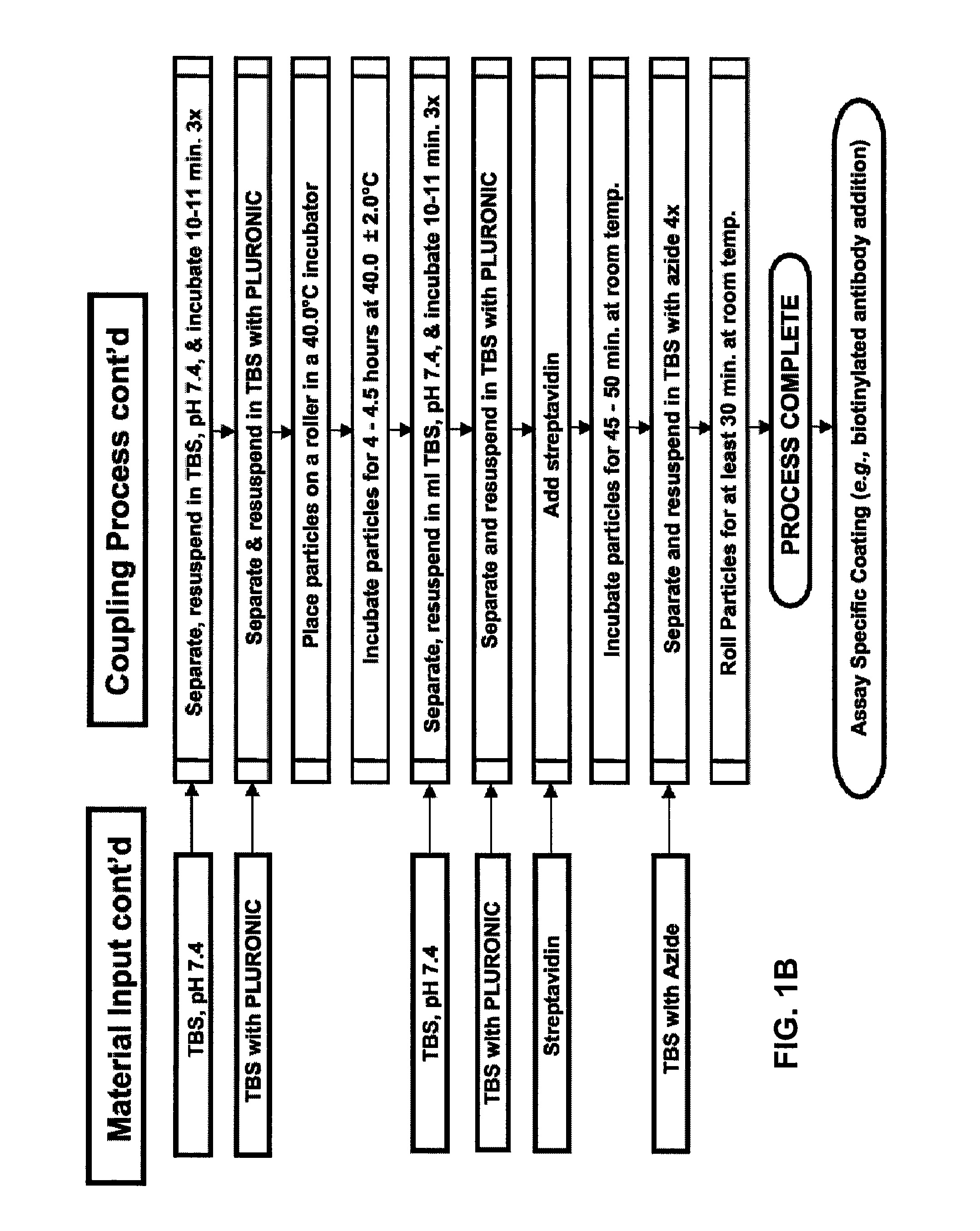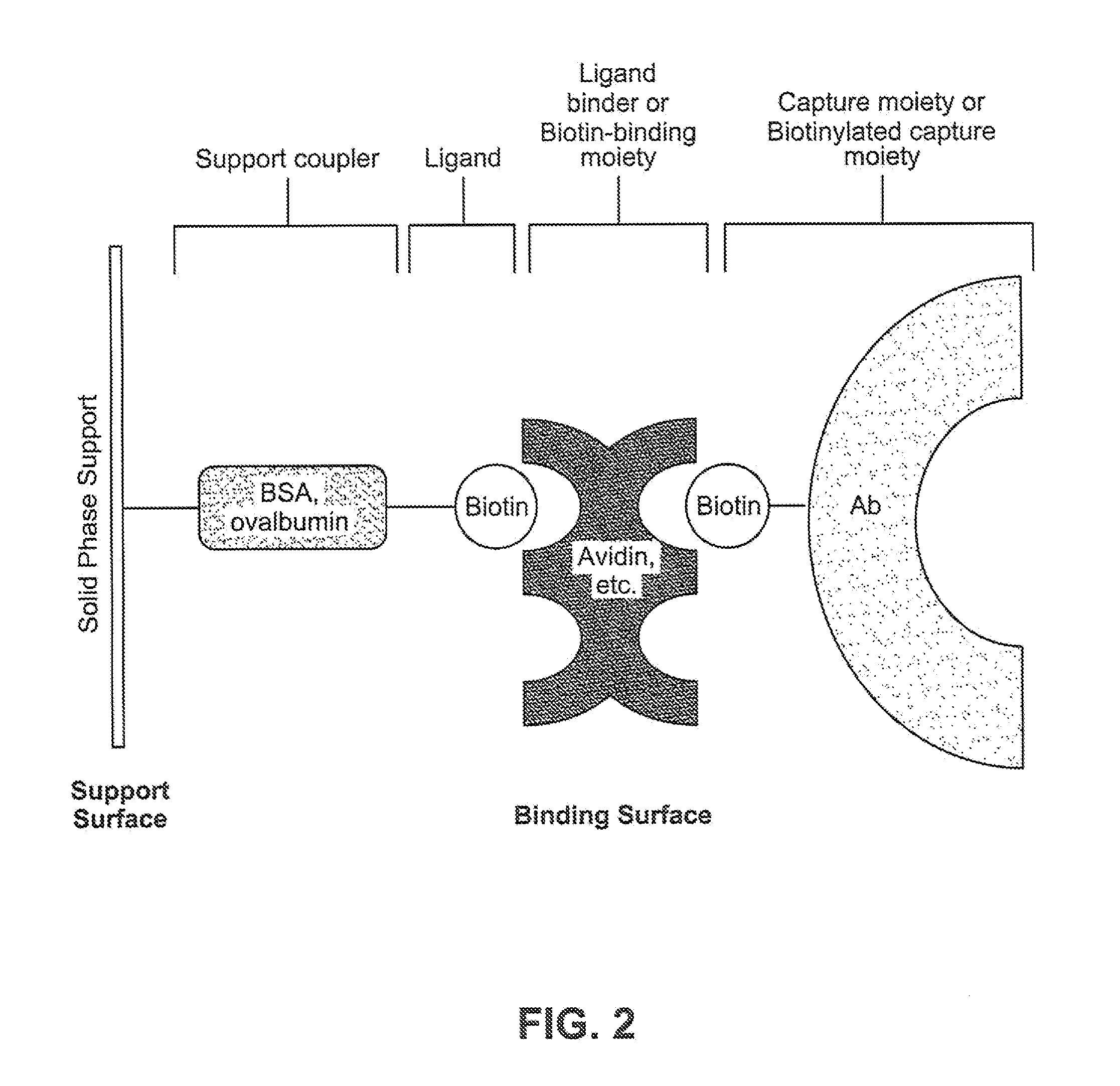Binding Surfaces for Affinity Assays
- Summary
- Abstract
- Description
- Claims
- Application Information
AI Technical Summary
Benefits of technology
Problems solved by technology
Method used
Image
Examples
example 1
Low Input Ratio Biotinylation of Bovine Serum Albumin
[0202]BSA was biotinylated with sulfo-NHS-LC-biotin (sulfosuccinimidyl-6-[biotinamido]hexanoate; Pierce Biotechnology Inc. / Thermo Scientific) at various molar input ratios of biotin to BSA (see Table 1). Briefly, sulfo-NHS-LC-biotin (556.59 g / mol) was dissolved in DMF (dimethylformamide) at a concentration of 30 milligrams per milliliter (mg / mL), and lyophilized BSA (bovine serum albumin, protease free; Celliance Corporation, a Serologicals Company; 66,000 g / mol) was dissolved in 0.05 M borate buffer pH 8.2 at a concentration of 15 to 20 mg / mL. The sulfo-NHS-LC-biotin solution was added to the BSA solution such that the final molar input ratio of sulfo-NHS-LC-biotin to BSA was from 3.4 to 30 (mol sulfo-NHS-LC-biotin:mol BSA). The reaction was incubated for 2 hours at 4° C., and then immediately dialyzed (i.e., diafiltration or dialysis) with 0.05M borate buffer pH 8.2 to remove excess sulfo-NHS-LC-biotin (i.e., biotin reagent, and...
example 2
Non-Saturation Decreases Binding Capacity but Increases Assay Signal
[0211]A non-saturated and orientated binding surface using a biotin / SA system was prepared with biotin-BSA prepared at a low molar input ratio of biotin to BSA (4:1) using PMPs. Briefly, a batch of microparticles having a non-saturated and orientated binding surface was prepared by coating Dynal® AKT-100 tosylactivated PMPs with low input ratio biotinylated BSA, blocking the biotin-BSA microparticles with Pluronic® F108, dispersing the blocked biotin-BSA microparticles in Pluronic® F108, and finally coating the biotin-BSA microparticles with SA. See Table 2, “BCI Sample.” For comparison, a commercially available biotin-binding microparticle (Dynal® DYNABEADS MyOne Streptavidin T1, Invitrogen Corporation) was tested. See Table 2, “Dynal® Control.” The non-saturated surface and the commercially available biotin-binding surface were each prepared using the same raw microparticle (Dynal® MyOne tosylactivated 1.0 micron ...
example 3
Making a Non-Saturated Surface Employing a Dispersion Step
[0219]Biotin-BSA prepared using a low molar input ratio of biotinylating reagent to BSA (4:1) was used in a dispersion method for making a non-saturated binding surface. Briefly, the biotin-BSA (prepared as described above) was covalently attached to Dynal® microparticles as described above to yield a surface that was non-saturated with respect to the number of biotins per unit support surface area. The coated microparticles were then employed in a dispersion step before adding SA.
[0220]Initial studies used a hemacytometer (microscope analysis) to assess the aggregation state of biotin-BSA coated microparticles, prepared as described above, (1) prior to the addition of SA, (2) after the drop-by-drop addition of a 10 mg / mL solution of biotin-BSA coated microparticles to a continuously mixing solution of SA (0, 125, 250, 375, 500, 750, or 1000 micrograms SA per mL), and (3) after the addition of different amounts of an 18 mg / mL...
PUM
| Property | Measurement | Unit |
|---|---|---|
| Volume | aaaaa | aaaaa |
| Volume | aaaaa | aaaaa |
| Volume | aaaaa | aaaaa |
Abstract
Description
Claims
Application Information
 Login to View More
Login to View More - R&D
- Intellectual Property
- Life Sciences
- Materials
- Tech Scout
- Unparalleled Data Quality
- Higher Quality Content
- 60% Fewer Hallucinations
Browse by: Latest US Patents, China's latest patents, Technical Efficacy Thesaurus, Application Domain, Technology Topic, Popular Technical Reports.
© 2025 PatSnap. All rights reserved.Legal|Privacy policy|Modern Slavery Act Transparency Statement|Sitemap|About US| Contact US: help@patsnap.com



